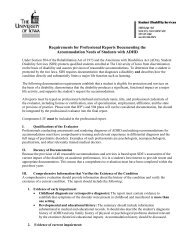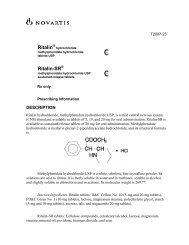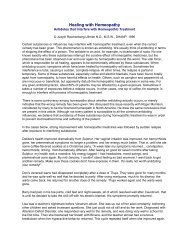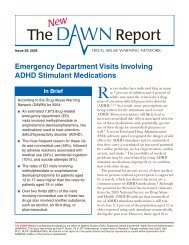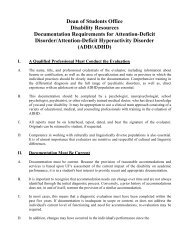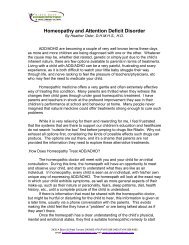Employees with Attention Deficit-Hyperactivity ... - ADHD Info Centre
Employees with Attention Deficit-Hyperactivity ... - ADHD Info Centre
Employees with Attention Deficit-Hyperactivity ... - ADHD Info Centre
- No tags were found...
Create successful ePaper yourself
Turn your PDF publications into a flip-book with our unique Google optimized e-Paper software.
Accommodation and Compliance Series<br />
<strong>Employees</strong> <strong>with</strong><br />
<strong>Attention</strong> <strong>Deficit</strong>-<strong>Hyperactivity</strong><br />
Disorder<br />
Job Accommodation Network<br />
PO Box 6080<br />
Morgantown, WV 26506-6080<br />
(800)526-7234 (V)<br />
(877)781-9403 (TTY)<br />
jan@jan.wvu.edu<br />
http://www.jan.wvu.edu<br />
A service of the Office of Disability Employment Policy, U.S. Department of Labor
Preface<br />
The Job Accommodation Network (JAN) is a service of the Office of Disability<br />
Employment Policy of the U.S. Department of Labor. JAN makes documents available<br />
<strong>with</strong> the understanding that the information be used solely for educational purposes.<br />
The information is not intended to be legal or medical advice. If legal or medical advice<br />
is needed, appropriate legal or medical services should be contacted.<br />
JAN does not endorse or recommend any products or services mentioned in this<br />
publication. Although every effort is made to update resources, JAN encourages<br />
contacting product manufacturers/vendors and service providers directly to ensure that<br />
they meet the intended purposes. This guarantees that the most up-to-date information<br />
is obtained.<br />
The following document is not copyrighted and reproduction is encouraged. Section<br />
105 of the Copyright Law provides that no copyright protection is available for works<br />
created by the U.S. Government. Therefore, all works created by JAN fall under this<br />
provision. While individuals may use such work <strong>with</strong> impunity, individuals may not<br />
claim copyright in the original government work, only in the original material added.<br />
Individuals may access the full text of the law from the U.S. Copyright Office<br />
http://www.loc.gov/copyright. Please note that specific information cited by JAN may be<br />
copyrighted from other sources. Citing secondary sources from a JAN publication may<br />
violate another organization's or individual's copyright. Permission must be obtained<br />
from these sources on a case-by-case basis. When using JAN materials, JAN asks that<br />
the materials not be reproduced for profit, that the tone and substance of the information<br />
are not altered, and that proper credit is given to JAN as the source of the information.<br />
For further information regarding this or any other document provided by JAN, please<br />
contact JAN.<br />
Authored by Suzanne Gosden Kitchen, M.A. Updated 6/2006<br />
Dedicated in memory of Mayda E. LaRosse<br />
2
JAN’S ACCOMMODATION AND COMPLIANCE SERIES<br />
Introduction<br />
JAN’s Accommodation and Compliance Series is designed to help employers determine<br />
effective accommodations and comply <strong>with</strong> Title I of the Americans <strong>with</strong> Disabilities Act<br />
(ADA). Each publication in the series addresses a specific medical condition and<br />
provides information about the condition, ADA information, accommodation ideas, and<br />
resources for additional information.<br />
The Accommodation and Compliance Series is a starting point in the accommodation<br />
process and may not address every situation. Accommodations should be made on a<br />
case by case basis, considering each employee’s individual limitations and<br />
accommodation needs. Employers are encouraged to contact JAN to discuss specific<br />
situations in more detail.<br />
For information on assistive technology and other accommodation ideas, visit JAN's<br />
Searchable Online Accommodation Resource (SOAR) at http://www.jan.wvu.edu/soar.<br />
<strong>Info</strong>rmation about <strong>Attention</strong> <strong>Deficit</strong>-<strong>Hyperactivity</strong> Disorder (AD/HD)<br />
What is AD/HD<br />
<strong>Attention</strong> deficit-hyperactivity disorder (AD/HD) is a neurobiological disorder that affects<br />
three to five percent of American children and adults. AD/HD is usually diagnosed in<br />
childhood, and the condition can continue into the adult years. Many individuals <strong>with</strong><br />
AD/HD are undiagnosed until adulthood (NINDS, 2006).<br />
The common characteristics of AD/HD are impulsivity, inattention, and/or over-activity<br />
(DSM-IV, 1994). Although individuals may have both inattention and hyperactivity<br />
symptoms, many individuals predominantly display one symptom more than another.<br />
Therefore, the DSM-IV identifies three subtypes that can be diagnosed:<br />
AD/HD predominantly hyperactive-impulsive type: The major characteristics are<br />
fidgeting, talking excessively, interrupting others when talking, and impatience.<br />
AD/HD predominantly inattentive type: The major characteristics are<br />
distractibility, organization problems, problems giving attention to details, and<br />
problems following through <strong>with</strong> instructions.<br />
AD/HD combined type: The individual <strong>with</strong> combined type meets the criteria for<br />
both hyperactive-impulsive and inattentive type.<br />
What causes AD/HD<br />
Many studies have linked AD/HD to genetics; other studies have suggested that<br />
prenatal problems and low birth weight may also be factors (NIMH, 2003).<br />
3
How is AD/HD treated<br />
Many adults are prescribed the same medications as children <strong>with</strong> AD/HD. Examples of<br />
medication include stimulant medications such as Strattera, and antidepressants such<br />
as Effexor and Wellbutrin (NIMH, 2003).<br />
Most experts agree that treatment for <strong>ADHD</strong> not be limited solely to the use of<br />
medications (NINDS, 2006). Treatment can include behavioral therapy, which can<br />
address time management, self-discipline, goal-setting, and decision-making (NINDS,<br />
2006).<br />
AD/HD and the Americans <strong>with</strong> Disabilities Act<br />
Is AD/HD a disability under the ADA<br />
The ADA does not contain a list of medical conditions that constitute disabilities.<br />
Instead, the ADA has a general definition of disability that each person must meet<br />
(EEOC, 1992). Therefore, some people <strong>with</strong> AD/HD will have a disability under the ADA<br />
and some will not. A person has a disability if he/she has a physical or mental<br />
impairment that substantially limits one or more major life activities, a record of such an<br />
impairment, or is regarded as having such an impairment (EEOC, 1992). To be a<br />
disability covered by the ADA, the impairment must substantially limit one or more major<br />
life activities. These are activities that an average person can perform <strong>with</strong> little or no<br />
difficulty. Examples are: walking, seeing, speaking, hearing, breathing, learning,<br />
performing manual tasks, caring for oneself, and working. These are examples only.<br />
Other activities such as sitting, standing, lifting, or reading are also major life activities<br />
(EEOC, 1992).<br />
Most courts have agreed <strong>with</strong> the activities listed by the EEOC. For example, in Brown<br />
v. Cox Medical Centers, 286 F.3d 1040 (8 th Cir. 2002), the Court noted that the “ability<br />
to perform cognitive functions” is a major life activity. In Gagliardo v. Connaught<br />
Laboratories, Inc., 311 F.3d 565 (3d Cir. 2002), the court held that “concentrating and<br />
remembering (more generally, cognitive function)” are major life activities (Fram, 2004).<br />
For more information about how to determine whether a person has a disability under<br />
the ADA, visit http://www.jan.wvu.edu/corner/vol02iss04.htm.<br />
4
Accommodating <strong>Employees</strong> <strong>with</strong> AD/HD<br />
Note: People <strong>with</strong> AD/HD may develop some of the limitations discussed below, but<br />
seldom develop all of them. Also, the degree of limitation will vary among individuals. Be<br />
aware that not all people <strong>with</strong> AD/HD will need accommodations to perform their jobs<br />
and many others may only need a few accommodations. The following is only a sample<br />
of the possibilities available. Numerous other accommodation solutions may exist.<br />
Questions to Consider:<br />
1. What limitations is the employee <strong>with</strong> AD/HD experiencing<br />
2. How do these limitations affect the employee and the employee’s job performance<br />
3. What specific job tasks are problematic as a result of these limitations<br />
4. What accommodations are available to reduce or eliminate these problems Are all<br />
possible resources being used to determine possible accommodations<br />
5. Has the employee <strong>with</strong> AD/HD been consulted regarding possible accommodations<br />
6. Once accommodations are in place, would it be useful to meet <strong>with</strong> the employee<br />
<strong>with</strong> AD/HD to evaluate the effectiveness of the accommodations and to determine<br />
whether additional accommodations are needed<br />
7. Do supervisory personnel and employees need training regarding AD/HD<br />
5
Accommodation Ideas:<br />
Time Management: Individuals <strong>with</strong> AD/HD may experience difficulty managing time,<br />
which can affect their ability to mark time as it passes incrementally by minutes and<br />
hours. It can also affect their ability to gauge the proper amount of time to set aside for<br />
certain tasks. It may be difficult to prepare for, or to remember, work activities that occur<br />
later in the week, month, or year.<br />
• Divide large assignments into several small tasks<br />
• Set a timer to make an alarm after assigning ample time to complete a task<br />
• Provide a checklist of assignments<br />
• Supply an electronic or handheld organizer, and train on how to use effectively<br />
• Use wall calendar to emphasize due dates<br />
o Develop a color-coded system (each color represents a task, or event, or<br />
level of importance)<br />
o Allow co-worker or supervisor to add entries on the calendar, or to doublecheck<br />
entries added by the employee <strong>with</strong> AD/HD<br />
Memory: Individuals <strong>with</strong> AD/HD may experience memory deficits, which can affect<br />
their ability to complete tasks, remember job duties, or recall daily actions or activities.<br />
• Provide written instructions<br />
• Allow additional training time for new tasks<br />
• Offer training refreshers<br />
• Use flow-chart to indicate steps in a task<br />
• Provide verbal or pictorial cues<br />
• Use post-it notes as reminders of important dates or tasks<br />
Concentration: Individuals <strong>with</strong> AD/HD may experience decreased concentration, which<br />
can be attributed to auditory distractions (that can be heard) and/or visual distractions<br />
(that can be seen). People <strong>with</strong> AD/HD report distractions such as office traffic and<br />
employee chatter, opening and closing of elevator doors, and common office noises<br />
such as fax tones and photocopying.<br />
• To reduce auditory distractions:<br />
o Purchase a noise canceling headset<br />
o Hang sound absorption panels<br />
o Provide a white noise machine<br />
o Relocate employee’s office space away from audible distractions<br />
o Redesign employee’s office space to minimize audible distractions<br />
• To reduce visual distractions:<br />
o Install space enclosures (cubicle walls)<br />
o Reduce clutter in the employee's work environment<br />
o Redesign employee’s office space to minimize visual distractions<br />
o Relocate employee’s office space away from visual distractions<br />
6
Organization and Prioritization: Individuals <strong>with</strong> AD/HD may have difficulty getting or<br />
staying organized, or have difficulty prioritizing tasks at work.<br />
• Develop color-code system for files, projects, or activities<br />
• Use weekly chart to identify daily work activities<br />
• Use the services of a professional organizer<br />
• Use a job coach to teach/reinforce organization skills<br />
• Assign a mentor to help employee<br />
• Allow supervisor to assign prioritization of tasks<br />
• Assign new project only when previous project is complete, when possible<br />
• Provide a “cheat sheet” of high-priority activities, projects, people, etc.<br />
Social Skills: Individuals <strong>with</strong> AD/HD may have limitations in adaptive skills, such as<br />
communicating <strong>with</strong> others, or exhibiting appropriate social skills. This might manifest<br />
itself as interrupting others when working or talking, demonstrating poor listening skills,<br />
not making eye contact when communicating, or inability to correctly read body<br />
language or understand innuendo.<br />
• Provide a job coach to help understand different social cues<br />
• Identify areas of improvement for employee in a fair and consistent manner<br />
• Make attendance at social activities optional<br />
• Use training videos to demonstrate appropriate behavior in workplace<br />
• Encourage employees to minimize personal conversation, or move personal<br />
conversation away from work areas<br />
• Provide sensitivity training (disability awareness) to all employees<br />
• Encourage all employees to model appropriate social skills<br />
• Adjust the supervisory method to better fit the employee’s needs<br />
• Allow the employee to work from home<br />
• Adjust method of communication to best suit the employee’s needs<br />
• Use role-play scenarios to demonstrate appropriate behavior in workplace<br />
<strong>Hyperactivity</strong>/Impulsivity: Individuals <strong>with</strong> AD/HD <strong>Hyperactivity</strong>-Impulsive type may<br />
exhibit over-activity or impulsive behavior. This could be disruptive to the work<br />
environment or could inhibit efficient and effective work performance.<br />
• Provide structured breaks to create an outlet for physical activity<br />
• Utilize a job coach to teach/reinforce techniques to control impulsivity<br />
• Allow the employee to work from home<br />
• Review conduct policy <strong>with</strong> employee<br />
• Adjust method of supervision to better prepare employee for feedback,<br />
disciplinary action, and other communication about job performance<br />
• Use services of EAP<br />
• Provide private workspace where employee will not disturb others by tapping,<br />
humming, or fidgeting<br />
7
Multi-tasking: Individuals <strong>with</strong> AD/HD may experience difficulty performing many tasks<br />
at one time. This difficulty could occur regardless of the similarity of tasks or the<br />
frequency of performing the tasks.<br />
• Separate tasks so that each can be completed one at a time<br />
• Create a flow-chart of tasks that must be performed at the same time, carefully<br />
labeling or color-coding each task in sequential or preferential order<br />
• Provide individualized/specialized training to help employee learn techniques for<br />
multi-tasking (e.g., typing on computer while talking on phone)<br />
• Identify tasks that must be performed simultaneously and tasks that can be<br />
performed individually<br />
• Provide specific feedback to help employee target areas of improvement<br />
• Remove or reduce distractions from work area<br />
• Supply ergonomic equipment to facilitate multi-tasking<br />
• Clearly represent performance standards such as completion time or accuracy<br />
rates<br />
Paperwork: Individuals <strong>with</strong> AD/HD may experience difficulty completing paperwork<br />
efficiently and effectively. This is due in part to workplace distractions and difficulty <strong>with</strong><br />
time management, disorganization, or prioritization.<br />
• When possible, automate paperwork by creating electronic files<br />
• Use speech recognition software to enter text or data into electronic files<br />
• Save time filling out paper forms by completing information in advance, using<br />
pre-filled forms, or adhering pre-printed stickers<br />
• Use checklists in place of writing text<br />
• Supply large quantities of regularly-used forms<br />
• Color-code forms for easy identification<br />
• Re-design commonly used forms<br />
o Use large font<br />
o Double space or triple space<br />
o Provide adequate space for hand-written response<br />
8
Situations and Solutions:<br />
A journalist <strong>with</strong> AD/HD experienced sensitivity to visual and auditory distractions. The<br />
employer provided the individual <strong>with</strong> a private, high-wall cubicle workspace in a lowtraffic<br />
area. The employer added an environmental sound machine to mask office noise.<br />
A social worker <strong>with</strong> AD/HD had difficulty completing handwritten paperwork in a neat<br />
and timely fashion. The employer created electronic forms for the employee, which<br />
allowed him to type responses. The employer arranged computer files labeled by month<br />
to help the employee prioritize open cases. The employer also sent email reminders of<br />
deadlines.<br />
An office worker <strong>with</strong> AD/HD experienced impulsivity and often interrupted co-workers<br />
by entering offices <strong>with</strong>out knocking. The employer helped identify appropriate<br />
techniques for approaching co-workers, such as keeping a daily list of tasks to discuss<br />
<strong>with</strong> others, then emailing or calling to set aside time to talk about work-related projects.<br />
A retail employee <strong>with</strong> AD/HD often forgot the closing and cash-out procedures, which<br />
resulted in missed printouts of daily sale reports. The employer created a numbered<br />
checklist that identified each step for proper closing procedures and identified which<br />
reports to run from cash registers. This accommodation benefited all employees.<br />
A delivery person <strong>with</strong> AD/HD had difficulty <strong>with</strong> time management. She spent<br />
excessive time making deliveries and would forget to return to the warehouse between<br />
daily runs. The employer provided a personal organizer watch that could be<br />
programmed to beep and display a written message many times throughout the day.<br />
This auditory and written prompt helped the employee move quicker from task to task,<br />
and helped remind her to return to the warehouse to gather her next load.<br />
A teacher <strong>with</strong> AD/HD experienced disorganization in her classroom due to clutter from<br />
many years of teaching. The employer provided a job coach to help the teacher learn<br />
organization techniques, to help separate and store items, and to dispose of previous<br />
student work and projects from yesteryear.<br />
Products:<br />
There are numerous products that can be used to accommodate people <strong>with</strong> limitations.<br />
JAN's Searchable Online Accommodation Resource (SOAR) at<br />
http://www.jan.wvu.edu/soar is designed to let users explore various accommodation<br />
options. Many product vendor lists are accessible through this system; however, upon<br />
request JAN provides these lists and many more that are not available on the Web site.<br />
Contact JAN directly if you have specific accommodation situations, are looking for<br />
products, need vendor information, or are seeking a referral.<br />
9
Job Accommodation Network (JAN)<br />
West Virginia University<br />
PO Box 6080<br />
Morgantown, WV 26506-6080<br />
Toll-free: (800)526-7234<br />
TTY: (877)781-9403<br />
Fax: (304)293-5407<br />
jan@jan.wvu.edu<br />
http://www.jan.wvu.edu<br />
Resources<br />
Office of Disability Employment Policy (ODEP)<br />
200 Constitution Avenue, NW, Room S-1303<br />
Washington, DC 20210<br />
Direct: (202)693-7880<br />
TTY: (202)693-7881<br />
Fax: (202)693-7888<br />
infoODEP@dol.gov<br />
http://www.dol.gov/odep/<br />
ADD Resources<br />
223 Tacoma Ave S #100<br />
Tacoma, WA 98402<br />
Direct: (253)759-5085<br />
Fax: (253)572-2470<br />
office@addresources.org<br />
http://www.addresources.org<br />
ADD Warehouse<br />
300 NW 70th Avenue<br />
Plantation, FL 33317<br />
Toll Free: (800)233-9273<br />
http://addwarehouse.com/shopsite_sc/store/html/index.html<br />
<strong>Attention</strong> <strong>Deficit</strong> Disorder Association<br />
PO Box 543<br />
Pottstown, PA 19464<br />
Direct: (484)945-2101<br />
Fax: (610)970-7520<br />
mail@add.org<br />
http://www.add.org<br />
10
<strong>Attention</strong> <strong>Deficit</strong> <strong>Info</strong>rmation Network<br />
58 Prince Street<br />
Needham, MA 02492<br />
Direct: (781)455-9895<br />
adin@gis.net<br />
http://www.addinfonetwork.com<br />
Children and Adults <strong>with</strong> <strong>Attention</strong> <strong>Deficit</strong> Disorder<br />
8181 Professional Place, Suite 201<br />
Landover, MD 20785<br />
Toll Free: (800)233-4050<br />
Direct: (301)306-7070<br />
Fax: (301)306-7090<br />
http://www.chadd.org<br />
11
References<br />
American Psychiatric Association. (1994). Diagnostic and statistical manual of mental<br />
disorders (4th ed.). Washington, DC.<br />
Equal Employment Opportunity Commission. (1992). A technical assistance manual on<br />
the employment provisions (title I) of the Americans <strong>with</strong> Disabilities Act.<br />
Retrieved October 28, 2005, from http://www.jan.wvu.edu/links/ADAtam1.html<br />
Fram, David. (2004). Resolving ADA workplace questions: How courts and agencies<br />
are dealing <strong>with</strong> employment issues. National Employment Law Institute<br />
Publication, 17th edition.<br />
National Institute of Mental Health (NIMH). (2003). <strong>Attention</strong> deficit hyperactivity<br />
disorder. Retrieved February 20, 2006, from http://www.nimh.nih.gov<br />
National Institute on Neurological Disorders and Stroke (NINDS) (2006). NINDS<br />
attention deficit-hyperactivity disorder information page. Retrieved August 23,<br />
2006 from http://www.ninds.nih.gov/disorders/adhd/adhd.htm<br />
12
This document was developed by the Job Accommodation Network, funded by a<br />
contract agreement from the U.S. Department of Labor, Office of Disability Employment<br />
Policy (Number J-9-M-2-0022). The opinions expressed herein do not necessarily<br />
reflect the position or policy of the U.S. Department of Labor. Nor does mention of trade<br />
names, commercial products, or organizations imply the endorsement by the U.S.<br />
Department of Labor.<br />
13



